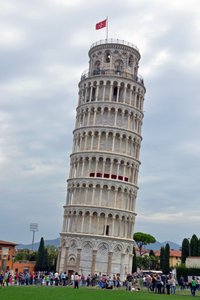Advertisement
Published: February 20th 2022

 Campanile - The Leaning Tower of Pisa
Campanile - The Leaning Tower of Pisa
Piazza del Duomo, Pisa, UNESCO World Heritage site. DSC_1078p1Pisa is a must for every traveler's itinerary. The Leaning Tower of Pisa is one of the true icons of travel. Its very image means "travel". I have traveled extensively over time and I had been to Italy before, but I had never been to the Leaning Tower. Actually beholding this icon in person was a "wow" travel moment for me.
Our tour bus parked at the Parcheggio Via Pietrasantina north of the historic district. This is an intercity bus station and parking area for motorcoaches and cars. (Motorcoaches are not permitted into the historic area.) One then boards a tourist trolley for the trip to the Pizza del Duomo. The tram let us off at the Pisa city wall, then we walked to the Porta Nova entrance to the Piazza del Duomo. As I walked though the gateway, there it was! The Leaning Tower!
The Leaning Tower of Pisa is officially, the freestanding Campanile (bell tower) of the Cathedral. Its design has been attributed to Diotisalvi or to Bonannus of Pisa and William of Innsbruck in 1173. The tower began to tilt after construction had progressed to the second floor in 1178 due to weak foundation soil. The

 Duomo - Pisa Cathedral
Duomo - Pisa Cathedral
Piazza del Duomo, Pisa, UNESCO World Heritage site. DSC_1074bell chamber on top was added in 1372, completing the tower. The main tower was designed in Romanesque style while the later bell chamber is Gothic. I find the cylindrical design with repeating single-order colonnades to be quite elegant. The Campanile would be considered an architectural gem even if it had never begun to lean. A project to shore up the tower took place from 1990 to 2001 and the tower now leans a little less than it once did. But, of course, it still has to lean! That's its charm and cachet! It is possible to climb the stairs inside the tower, but we admired it from the ground.
When one walks through the Port Nuova to behold the Piazza del Duomo, four magnificent structures vie for one's attention. Largest of these is the Duomo, the Cathedral of Santa Maria Assunta (St. Mary of the Assumption). It is the centerpiece of the Piazza del Duomo. Construction of Pisa cathedral began in 1063 under the architect Buscheto ((fl.1063–1110)). Buscheto was the founder of the distinctive Tuscan Romanesque style in which the cathedral is built. The rounded arches in the four open galleries of the facade show a Moorish influence

 Porta di San Ranieri
Porta di San Ranieri
Pisa Cathedral (Duomo). Porta di San Ranieri, by Bonannus of Pisa (1180). Bronze doors on the south transept. The panels depict the life of Jesus, beginning with the Annunciation at lower left.
DSC_0009p1on the design. (Pisa, a sea power at that time, had just defeated Moorish controlled Sicily and brought home many of its artisans.) The exterior is a wonderful confection of white Carrera marble.
We did go inside the Duomo. The interior continues the Tuscan Romanesque colonnade style despite rebuilding in the 17th century. The gilded coffered ceiling commands attention as does the marble pulpit carved by Giovani Pisano in 1302-1311. Mosaics adorn the apse and the inside of the dome. A particularly interesting side chapel is the tomb of St. Ranieri (c. 1115/7 – 1160). He is the patron saint of Pisa and of travelers! Don't overlook the the bronze Porta di San Ranieri, by Bonannus of Pisa (1180). an architect of the Leaning Tower, at the rear of the Duomo. The panels depict the life of Jesus.
In front of he Duomo, and actually the first structure one encounters in the Piazza del Duomo, is the Battistero (Baptistry). The circular marble Baptistry was begin in 1153 by Diotisalvi and completed in 1363.The Baptistry is said to exemplify the transition from Romanesque style to Gothic style. The lower level is in the Romanesque style, with rounded arches, while

 Duomo: Nave and Main Altar
Duomo: Nave and Main Altar
Pisa Cathedral (Duomo). Nave and main altar (1774). DSC_0023p1the upper levels are in the Gothic style, with pointed arches.
All are part of the Piazza del Duomo, Pisa, UNESCO World Heritage site.
Paninoteca Il Canguro was a perfect spot for a quick lunch in Pisa. We discovered it walking up Via Santa Maria, the street leading from the Leaning Tower into town. We ate outside. I ordered a Prosciutto Panini sandwich that was served on fresh bread with a nice dressing. It filled the bill perfectly! I suppose that their trade depends on visitors to Pisa. (Their sign advertises the the establishment as "The First and the Oldest Fast Food in Pisa"!) The food and service were good and I recommend it!
Returning to the Piazza del Duomo, we admired the Campo Santo. Built ca. 1270-1278, the structure forms a courtyard surrounding the Pisa Cathedral burial ground. Compared to the decorative Campanille, Duomo and Battistero, the Camp Santo has almost clean lines, despite its description as Tuscan Gothic in style. Dare I say it? It reminded me of a Forest Lawn mausoleum. (But then that is where they went to get the idea.)
Advertisement
Tot: 0.097s; Tpl: 0.015s; cc: 10; qc: 23; dbt: 0.0455s; 1; m:domysql w:travelblog (10.17.0.13); sld: 1;
; mem: 1.1mb



























D MJ Binkley
Dave and Merry Jo Binkley
Architecture
The beauty of Italy.